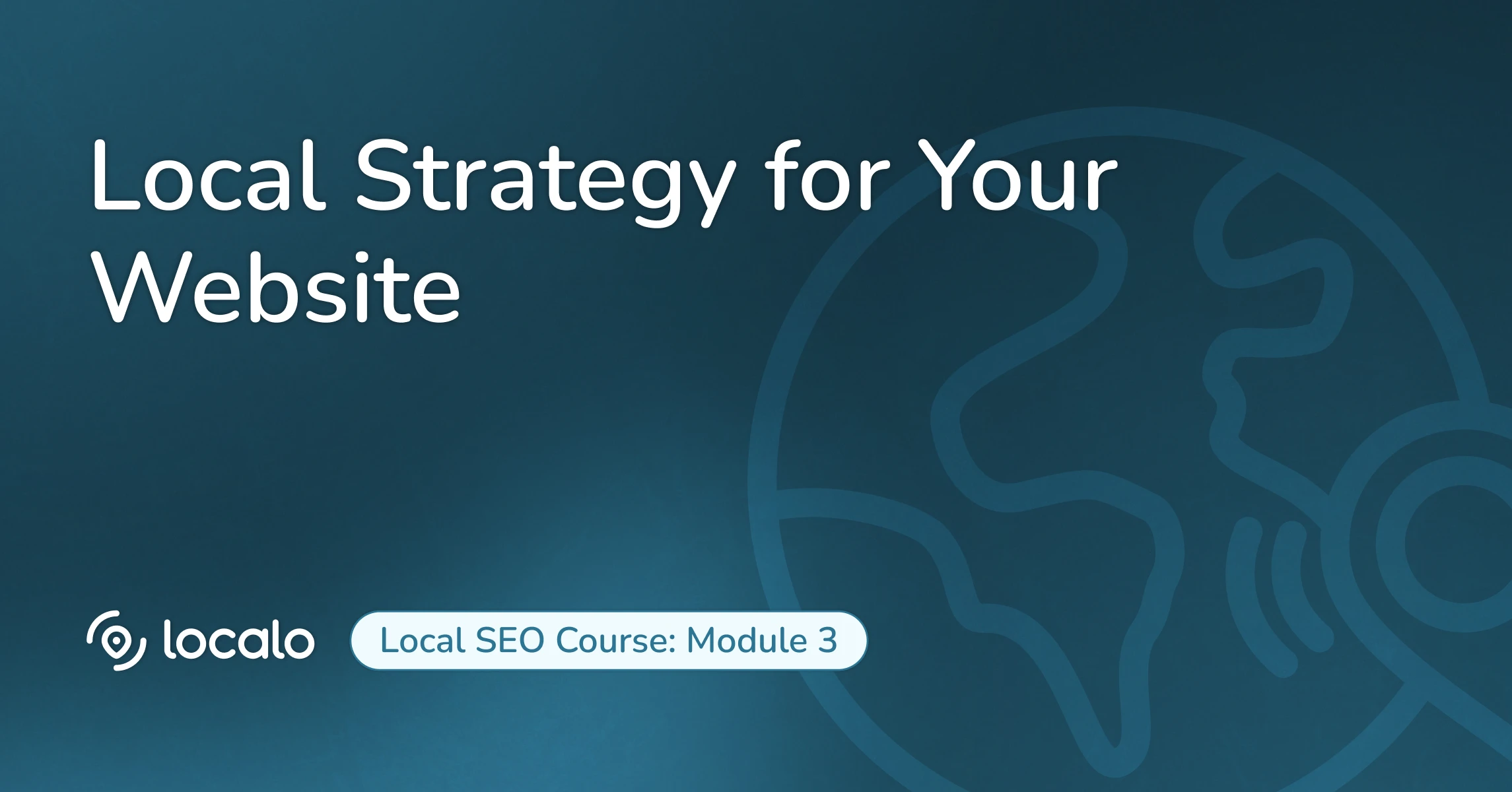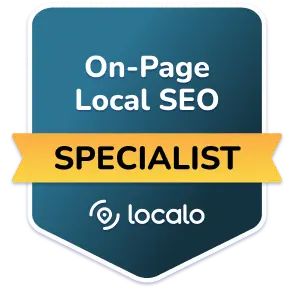Welcome back to our Complete Local SEO Course. In Modules 1 and 2, we covered local search fundamentals and mastered your Google Business Profile. Now it’s time to make your website work hand-in-hand with that optimized profile.
In previous modules, we encouraged you to think of your Google Business Profile as a digital storefront. Now do the same for your website, but as the store inside. Let’s make sure that when people want to learn more, your website delivers exactly what they’re looking for.
In this module, we’re here to teach you the on-page essentials that turn websites into local customer magnets. We’ll start with the big picture, then dive into the specific tactics that get results.
What is On-Page Local SEO?
Before we jump into tactics, let’s make sure we’re on the same page about what on-page SEO actually means.
On-page SEO is everything you do directly on your website to help search engines understand what your business offers and where you serve customers. Think of it as organizing your digital storefront so both Google and potential customers can easily find what they’re looking for.
For local businesses, on-page SEO includes:
- Keyword optimization - Using the words your customers actually search for
- Page structure - Organizing information so it makes sense to both visitors and search engines
- Technical elements - Title tags, headers, and behind-the-scenes code that tells Google about your business
- User experience - Making sure your site loads fast and works perfectly on mobile devices
- Internal links - Connecting your pages together in ways that guide visitors and search engines
The goal? When someone in your area searches for what you offer, Google confidently shows your website because it clearly demonstrates you’re the local expert they need.
Priorities for a Local Website Strategy
Here’s something most courses get wrong: they teach tactics without strategy. Before you start optimizing individual pages, you need a clear plan that connects everything together.
Local Business Website Hierarchy
Think of your website like a well-organized filing cabinet:
Level 1: Homepage (Your main folder) This is your headquarters. It should immediately communicate what you do, where you serve, and why someone should choose you.
Level 2: Main Service Pages (Your department folders) Each major service gets its own page that thoroughly explains what you offer and how you help customers in your area.
Level 3: Location Pages (Your regional folders) If you serve multiple areas, each location gets a dedicated page that speaks specifically to that community’s needs.
Level 4: Supporting Content (Your reference files) Blog posts, FAQs, and educational content that help customers understand their problems and your solutions.
What to Optimize First
Not all pages are created equal. Here’s the order that gets the fastest results:
- Homepage - Most visitors land here first
- Primary service pages - These drive most of your revenue
- Contact/location pages - Critical for turning nearby searchers into customers
- Secondary service pages - Expand your keyword coverage
- Supporting content - Build long-term authority
This approach ensures you’re building on a strong foundation rather than randomly optimizing pages.
Hey Local Business Champs! Welcome back to Localo’s Complete Local SEO Course!
So, in Modules 1 and 2, we covered local search fundamentals and mastered your Google Business Profile. Now here’s what we’re going to do - it’s time to make your website work hand-in-hand with that optimized profile.
Think about this for a second - your Google Business Profile? That’s your digital storefront. But your website? That’s the actual store inside! And we need to make sure that when people want to learn more, your website delivers exactly what they’re looking for. Because here’s the thing - if someone clicks from your Google listing to your website and gets confused or can’t find what they need, you’ve just lost a potential customer.
So here’s what we’re doing in this module - we’re teaching you the on-page essentials that turn websites into local customer magnets. No complicated tech stuff here, just smart organization that actually gets results.
What is on-page local SEO, and why should you care?
Alright, before we jump into tactics, let me make sure we’re on the same page about what on-page SEO actually means. Because this is where a lot of business owners get overwhelmed, but it’s really not that complicated.
On-page SEO - it’s everything you do directly on your website to help search engines understand what your business offers and where you serve customers. Think of it like organizing your digital storefront so both Google and potential customers can easily find what they’re looking for. Just like you wouldn’t leave your physical store with missing price tags or confusing signs, right?
Now, for local businesses specifically, on-page SEO includes several key areas, and I want to break these down so they make sense.
First up - keyword optimization. That means using the words your customers actually search for. Not the fancy industry jargon you might use, but the actual phrases people type into Google when they have a problem you can solve.
Second - page structure, which is organizing information so it makes sense to both visitors and search engines. Think of this like creating a clear path through your store so customers can find what they need without getting lost.
Third - technical elements like title tags, headers, and all that behind-the-scenes code that tells Google about your business. Don’t worry - this isn’t as scary as it sounds. It’s more like putting the right labels on everything so Google knows exactly what you offer.
Fourth - user experience, making sure your site loads fast and works perfectly on mobile devices. Because think about it - if someone’s searching for an emergency plumber on their phone and your site takes forever to load, they’re calling your competitor instead.
And fifth - internal links, connecting your pages together in ways that guide both visitors and search engines through your site. It’s like creating a helpful map that shows people exactly where to go next.
So what’s the goal here? When someone in your area searches for what you offer, Google confidently shows your website because it clearly demonstrates you’re the local expert they need. That’s the difference between getting found and being invisible online.
Why do most courses get this completely wrong?
Here’s something that drives us crazy about most courses - they teach tactics without strategy. They’ll tell you to optimize this page and fix that tag, but they never give you a clear plan that connects everything together. It’s like trying to build a house by randomly nailing boards together without blueprints.
Before you start optimizing individual pages, you need a clear plan that makes sense for your business and your customers.
So picture this - think of your website like a well-organized filing cabinet with four levels. And just like a good filing system, everything has its place and everything makes sense.
Level 1 is your homepage - that’s your main folder. This is your headquarters, right? It should immediately communicate what you do, where you serve, and why someone should choose you over your competitors. Think of this as your elevator pitch - you’ve got about ten seconds to convince someone you’re worth their time.
Level 2 - these are your main service pages, your department folders. Each major service gets its own page that thoroughly explains what you offer and how you help customers in your area. These are your money-making pages, so they need to be crystal clear about what you do and why customers should choose you.
Level 3 covers location pages - your regional folders. If you serve multiple areas, each location gets a dedicated page that speaks specifically to that community’s needs. Because someone in downtown Denver has different concerns than someone in the suburbs, right?
And level 4 is supporting content - your reference files. We’re talking blog posts, frequently asked questions, and educational content that helps customers understand their problems and your solutions. These pages build trust and show you’re the expert in your field.
What should you optimize first for fastest results?
Now here’s the thing - not all pages are created equal. And if you try to optimize everything at once, you’ll drive yourself crazy and not see the results you want. So here’s the order that gets the fastest results, based on what actually matters most for your business.
First - your homepage, because most visitors land here first. This is often their first impression of your business, so it needs to be absolutely perfect. Get this right, and everything else becomes easier.
Second - primary service pages, because these drive most of your revenue. These are the pages that turn visitors into paying customers, so they deserve your immediate attention.
Third - contact and location pages, which are absolutely critical for turning nearby searchers into customers. Think about it - if someone wants to hire you but can’t figure out how to reach you or where you’re located, you’ve lost them.
Fourth - secondary service pages to expand your keyword coverage. Once you’ve got your main services ranking well, these help you capture more traffic from related searches.
And fifth - supporting content to build long-term authority. This is your long-term investment in becoming the go-to expert in your area.
This approach? It ensures you’re building on a strong foundation rather than just randomly optimizing pages and hoping for the best. You’ll see faster results because you’re focusing on what matters most first.
Great! So you now understand the strategic approach to on-page SEO. In our next video, we’re going to tackle your homepage optimization and show you the ten-second test that can make or break your first impression. Because if your homepage isn’t converting visitors into customers, nothing else matters. Thanks for joining me today, and I’ll see you in the next video!
The websites and Google Business Profiles used throughout the course are for educational purposes only. We're not affiliated with these businesses and don't claim any endorsement from them. All trademarks belong to their owners. Some examples include visual changes (made with browser tools) to help illustrate the SEO concepts we're teaching. These edits are strictly local and illustrative of specific SEO concepts. They don't affect the original websites.



